Miami II (CL‑89)
1943–1961
A port city located on Biscayne Bay in southeastern Florida.
II
(CL-89: displacement 10,000; length 610'1"; beam 66'4"; draft 20'; speed 33 knots; complement 992; armament 12 6-inch,12 5-inch, 28 40-millimeter, 10 20-millimeter; aircraft 2 Vought OS2U-2 Kingfishers; class Cleveland)
The second Miami (CL-89) was laid down on 2 August 1941 at Philadelphia, Pa., by Cramp Shipbuilding Co.; launched on 8 December 1942; and sponsored by Mrs. Mary J. Reeder, the wife of Mr. Clifford H. Reeder, the mayor of Miami, Fla.
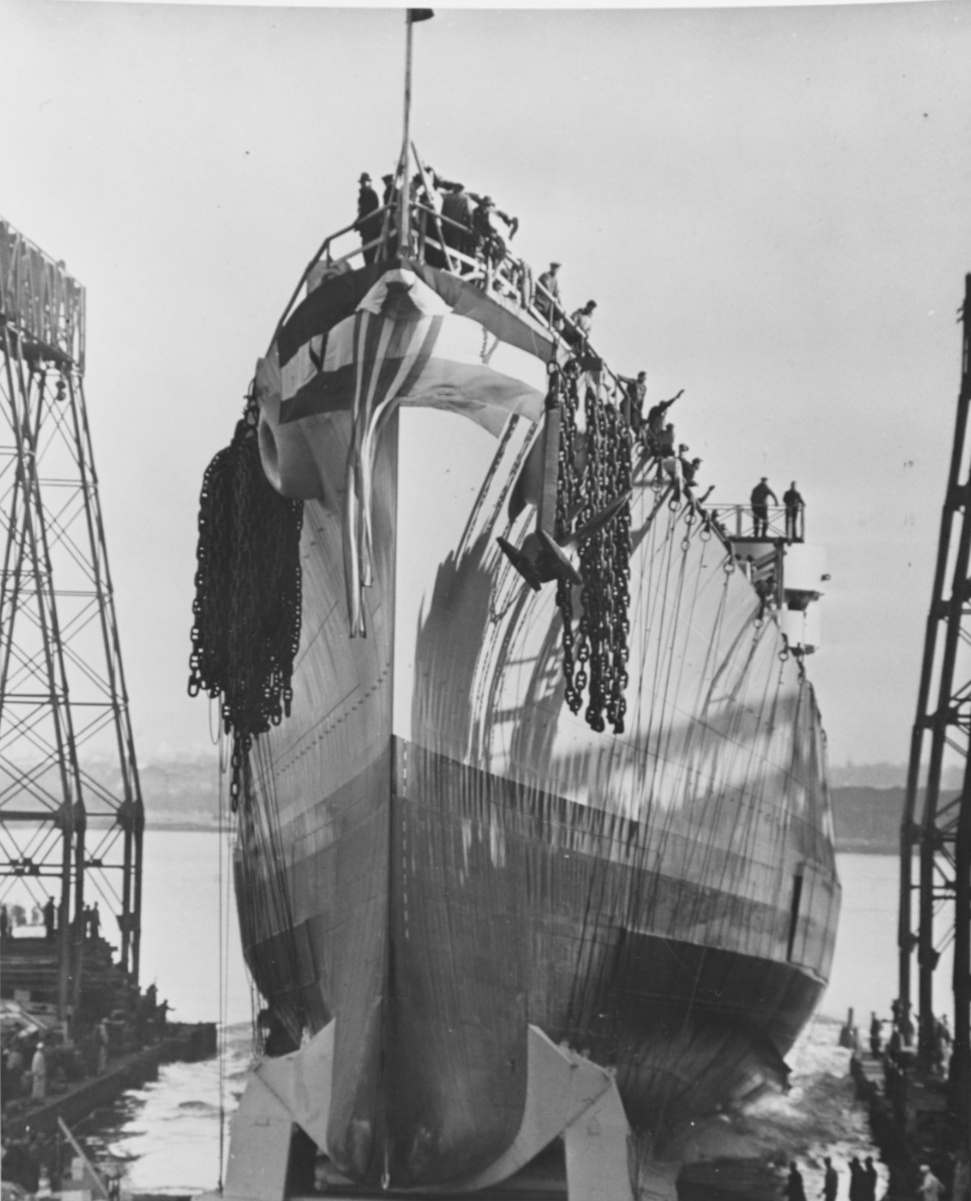
Commissioned at the Philadelphia Navy Yard on 28 December 1943, Capt. John G. Crawford in command, Miami fitted out there (29-31 December). On 1 January 1944, she carried out a trial run on the Delaware river, and returning later that same day. From 21 January to 3 February she continued fitting out and loaded ammunition.
![Miami underway in the Delaware River, 30 January 1944, painted in a disruptive camouflage, Measure 32, Design 1D. (U.S. Navy Bureau of Ships Photograph BS [Bureau of Ships] 60605, National Archives and Records Administration, Still Pictures Divis... Miami underway in the Delaware River, 30 January 1944, painted in a disruptive camouflage, Measure 32, Design 1D. (U.S. Navy Bureau of Ships Photograph BS [Bureau of Ships] 60605, National Archives and Records Administration, Still Pictures Divis...](/content/history/nhhc/research/histories/ship-histories/danfs/m/miami-ii/_jcr_content/body/media_asset_496220439/image.img.jpg/1561383364885.jpg)
On the 4th, Miami set a course for the Delaware Bay where she conducted exercises for several days. On the 7th she departed those waters in company with the destroyer Twiggs (DD-591) and steamed to the Chesapeake Bay where the two conducted drills.
On 12 February 1944, Miami got underway from the Chesapeake Bay and in the late afternoon moored at the Norfolk Navy Yard, Portsmouth, Va. Underway again on the 14th, at 0835 she weighed anchor and shaped a course for Trinidad, British West Indies, to conduct her shakedown. She steamed to the Caribbean in company with the heavy cruiser Quincy (CA-71) and the destroyers Carmick (DD-493) and Doyle (DD-494). On the second day of her voyage she encountered heavy seas and at approximately 0415, Sea2c Leonard S. Dera, a native of Buffalo, N.Y., fell overboard. Despite a search for him for over an hour, Dera was never recovered.
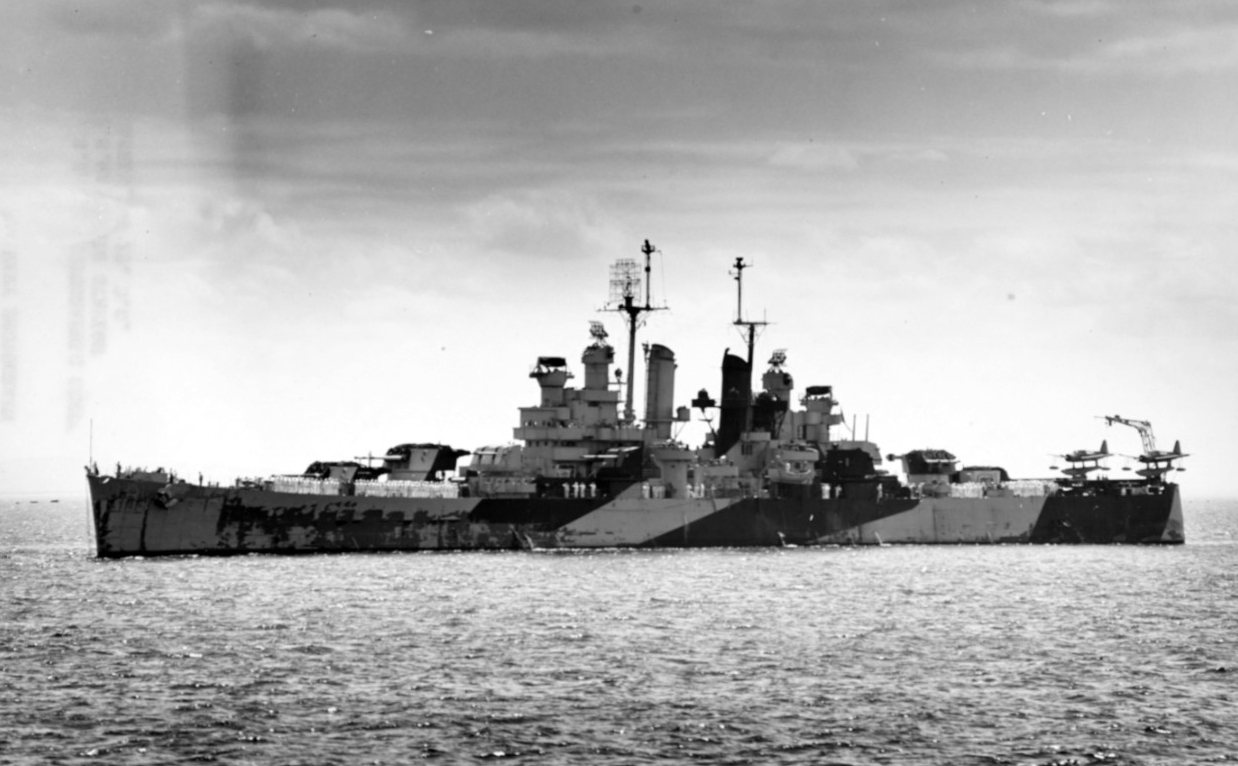
Miami passed through the Boca de Navios Channel on 18 February 1944 and shortly thereafter anchored inside the submarine net off Trinidad. From 19 February to 1 March the cruiser shifted between Trinidad and the Gulf of Paria to participate in drills and exercises. On 3 March, at 0522 she departed Trinidad and began her voyage back to Norfolk accompanied by Quincy and the destroyers Baldwin (DD-624) and Thompson (DD-627). She arrived at Norfolk without incident on the 7th.
Rear Adm. Donald B. Beary briefly inspected Miami on 8 March 1944, and then two days later on the 11th she got underway for the Naval Research Laboratory Annex, Chesapeake Bay, Md. Her testing at that location concluded on the 12th and she steamed to the Delaware Bay arriving there the following day. At 0705, on 14 March, Miami moved on to Philadelphia and moored to Pier 2. She remained in dry dock for post shakedown repairs through 30 March.
Miami stood out from Philadelphia on 2 April 1944 and that same day arrived at the South Boston Annex, Ma., and moored, port side to the East Jetty. On 7 April she got underway for Casco Bay, Maine, to conduct firing drills with the light cruiser Houston (CL-81), destroyer Edwards (DD-619) and destroyer escort Francis M. Robinson (DE-220). Following a week of such work, on 14 April, she made her way back to Boston in company with Edwards.
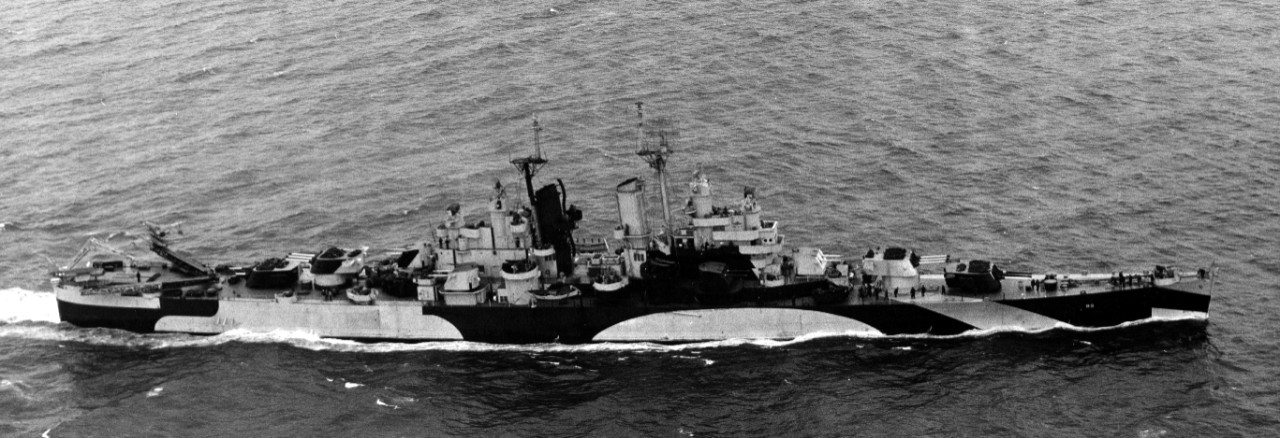
Ordered to go to the Pacific, Miami got underway on 16 April 1944, for Balboa, C.Z., as part of Task Group (TG) 27.7, which included the light cruiser Vincennes (CL-64), Houston, Edwards, and the destroyers Monssen (DD-798), Broome (DD-210) and Simpson (DD-221). After nearly a week at sea, on 22 April, Miami commenced her transit of the Panama Canal, completing the journey at 1844 that same day and mooring to Pier 7 at Balboa. The following day she got underway for San Diego, Calif., in company with TG 12.3, which consisted of Vincennes, Houston, Edwards and Monssen.
On 30 April 1944, Miami arrived at San Diego and went alongside the Broadway Pier. Still with her task group the ship made a quick turnaround and set out for Pearl Harbor, T.H., early the following day. The cruiser arrived safely at Pearl on 6 May and moored in berth H-4. The ship conducted exercises with the heavy cruiser Indianapolis (CA-35) on the 8th but remained in the vicinity of Pearl. She shifted over to berth B-7 on the 13th for upkeep and voyage repairs, which lasted through the 24th.
The next phase of Miami’s participation in the Pacific theater of the war began on 24 May 1944, when the cruiser stood out and began her voyage to Majuro Atoll, Marshall Islands, as a part of TG 12.1, which consisted of the battleships North Carolina (BB-55), and Washington (BB-56), cruisers Vincennes and Houston, the minelayer Terror (CM-5), and the destroyers Dortch (DD-670), Lang (DD-399), McCalla (DD-488), Sterett (DD-407), Wilson (DD-408) and Cotton (DD-669). She entered the Calalin Channel on 30 May, and anchored in berth 174, Majuro.
In June 1944, Miami joined the Fast Carrier Task Force conducting air strikes on Japanese held islands in the Marianas. The first of these air attacks began on 6 June, Miami setting out as a part of TG 58.7, which included the aircraft carrier Essex (CV-9) and the small carriers Langley (CVL-27) and Cowpens (CVL-25). At 1258 on 11 June, Essex, Langley, and Cowpens launched their planes as part of a fighter sweep against Saipan, Marianas, and on the 13th the carriers initiated their scheduled strikes. Further attacks were carried out from the 15th to the 17th against Iwo Jima in the Bonin Islands. On 19 June, the Japanese launched retaliatory air attacks against the group and although not heavily engaged Miami fired on at least one enemy plane with unknown results. On the same day as the air attack the cruiser also fired her 5-inch guns at a reported submarine, although the object turned out to be nothing more than a derelict Sampan.
Miami screened Essex on 21 June 1944, while the carrier conducted air strikes against Guam and Rota. The attacks continued through the 27th until Miami, acting as a part of Task Unit (TU) 58.4.5, received orders to conduct a bombardment of the two islands. The task unit consisted of Houston, and destroyers Charles Ausburne (DD-570), Dyson (DD-572), Stanly (DD-478), Converse (DD-509), and Spence (DD-512). Miami and the others arrived at Rota at 0818 on the 27th and abruptly opened fire on Japanese military targets in the area. The cruiser shelled several buildings on shore and also struck an enemy cargo ship moored at Apra harbor. At the end of the engagement, she exchanged fire with, and eventually silenced, an enemy shore battery located at Orote Point. Following the bombardment, another wave of carrier strikes commenced and the cruiser resumed her position with the task force.
Miami briefly parted company with the carrier task force on 6 July 1944 to re-supply at Eniwetok Atoll, Marshall Islands. She then returned to the action on the 14th as the carriers launched strikes against Guam, Tinian, and Rota through the 30th. On 31 July, the cruiser steamed to Saipan with TG 58.3, which included the aircraft carriers Bunker Hill (CV-17), and Lexington (CV-16), and the small carrier San Jacinto (CVL-30). She arrived in Saipan that same day and moored in berth A-29. Early in the morning on 1 August she stood out from Saipan with TG 58.3, and on the 4th the group commenced carrier strikes on enemy bases located at Iwo Jima. On 11 August, Miami steamed back to Eniwetok for upkeep. After several weeks undergoing maintenance, she finally got back underway on the 25th in company with TU 58.2.1, which consisted of the small cruiser Vicksburg (CL-86), and the destroyers Stephen Potter (DD-538), Marshall (DD-676), Benham (DD-796) and Wedderburn (DD-684).
While again supporting the carrier task group on 26 August 1944, Miami briefly steamed independently to pick up a disabled Vought Kingfisher from the battleship Indiana (BB-58) but was shortly thereafter called off from the task. The cruiser returned to sea on 30 August and accompanied TG 34.6 in support of carrier strikes against Peleliu and Angaur in the Palau Islands on 7 September. From the 12th to the 15th the carrier operations shifted over to the central Philippines. On 14 September, Miami rescued a downed Grumman F6F-5 Hellcat pilot (BuNo 58921), Lt. (j.g) Dan B. Driscoll, assigned to Fighting Squadron (VF) 31 operating on the light aircraft carrier Cabot (CVL-28). On the 28th Miami shifted into berth H-34 off Saipan for replenishment.
On 29 September 1944, Miami returned to sea with Task Force (TF) 34 to conduct exercises. The capital ships of the task force consisted of the battleships New Jersey (BB-62), Iowa (BB-61), Alabama (BB-60) and Washington, as well as the small aircraft carrier Independence (CVL-22). On the 30th, following the conclusion of the exercises, Miami steamed to Ulithi Atoll, Caroline Islands, and anchored in berth 32. On 6 October she departed Ulithi with TG 38.2, and on the 10th the group’s carriers initiated air attacks against Okinawa in the Ryūkyūs. On the 12th the carriers shifted their focus to Formosa [Taiwan] and while their planes were deployed, at approximately 1855, a contingent of enemy aircraft launched a counterattack against the group.
Shortly after obtaining information regarding the approaching enemy planes Miami went to general quarters. At 1902 the first plane appeared, and the cruiser let loose a barrage of anti-aircraft fire. During the fight Miami brought down her first enemy plane and contributed to the splashing of at least one more. On 13 October 1944, at 0140, several hours after the first attack abated, Japanese planes made another strike against Miami’s group and she managed to splash another one of them just off her port beam. Beginning later that morning and continuing well into the next day the task force’s carriers launched additional strikes against Formosa.
As of 18 October 1944 carrier attacks continued against Aparri and Laoag in the Philippines. On the 20th the operations tempo picked up significantly as the Seventh Fleet landed General Douglas A. MacArthur, USA, and his troops at Leyte. From the 21st to the 24th the carriers in Miami’s task force launched multiple strikes in the central Philippines. The enemy forces in the region tenaciously resisted the U.S. thrust and the still formidable Imperial Japanese Navy deployed to the region in force, seeking a decisive engagement, converging on Leyte Gulf from three directions and resulted in the multi-faceted action known as the Battle of Leyte Gulf. During this momentous clash, Miami operated with Rear Adm. Gerald F. Bogan’s carrier task group, and closely screened the carriers Intrepid (CV-11), Hancock (CV-19), and Bunker Hill. Planes from the flattops proved instrumental in the eventual attack against the Japanese Center Force in the Sibuyan Sea on 24 October, which resulted in the sinking of the 18-inch gunned battleship Musashi.
In the confusion that surrounded the Leyte operations, however, Adm. William F. Halsey, Jr., Commander of the Third Fleet, learned that the Japanese center force, previously thought to be withdrawing, had reversed course and was bound for the beachhead at Leyte where numerous vulnerable U.S. amphibious ships were located. Miami was dispatched with Rear Adm. Bogan’s group to intercept the advancing Japanese naval force. Miraculously, U.S. light forces – destroyers and destroyer escorts, in addition to swarms of planes from the escort carriers being protected by those ships, managed to turn them back. Nonetheless, on 26 October 1944, Miami and her cohorts intercepted the Japanese destroyer Nowaki near the entrance of the San Bernadino Strait. Miami, in concert with the other cruisers and destroyers accompanying her, fired multiple salvos from her main battery of 6-inch guns and the combined effort sent Nowaki to the bottom.
On 27 October 1944, Miami with TG 38.2 moved eastward of the Philippines and carrier strikes were executed in earnest against enemy airfields and bases located at Luzon from 5 to 6 November. The cruiser anchored independently at Ulithi from the 9th to the 13th and then got back underway to rejoin her task group on the 14th. Strikes were conducted on Luzon from 18 to 25 November and during that time Miami routinely prepared for counterattacks by enemy aircraft. A particularly significant counterattack occurred on the 25th while the carriers’ planes were still deployed, and during the subsequent engagement, Miami managed to splash a Japanese dive bomber that passed over the top of her. The following day she returned to Ulithi where she replenished her stores and conducted exercises well into the next week.
Miami got underway with TG 30.4 on 9 December 1944 and supported a series of carrier strikes against Luzon from the 14th to the 16th. A severe typhoon struck the area on the 18th and severely allayed the group’s operations. Heavy waves damaged one of Miami’s OS2U-3 Kingfishers of Cruiser Scouting Squadron 14 and tossed the other one (BuNo 01278) into the sea The tempest also badly damaged the ship causing her to “buckle at frames 21-33.” As the storm abated on the 20th, Miami assisted TF 38 in searching for survivors and jettisoned her other irreparable Kingfisher (BuNo 09441). The weather remained hazardous for several more days, making any additional attacks on Luzon impossible and on the 24th Miami anchored at Ulithi.
Back at sea on 1 January 1945, Miami steamed with TG 38.3, supporting carrier attacks against shore installations and shipping off Formosa. From the 6th to the 8th the carriers’ focus turned briefly to Luzon. On 9 January, the ship transited the Bashi Channel and at 0000 on the 10th, in company with TF 38, entered the South China Sea. On 12 January, the carriers struck targets in Japanese-occupied French Indo-China [Vietnam, Lao, and Cambodia] and on the 15th their attention turned back to Formosa and the Chinese coast. On the 16th, during an airstrike against Formosa, Miami sighted and shot down a Mitsubishi A6M5 Type 0 carrier fighter (Zeke). In company with her task force, Miami transited the Balingtang channel, Luzon Straits, on the 20th and on the 21st the carriers attacked Okinawa.
On 27 January 1945, Miami anchored at Ulithi. She got underway again on 10 February with TG 58.1. On the 15 th, the group reached its designated attack position and commenced a series of night runs on the Tokyo area, which continued through the 17th. On 18 February, the group attacked Chichi Jima and from 20 to 22 February additional runs were made on Okinawa in support of U.S. troop landings taking place on the island. Support for these operations continued through the end of the month and on 2 March, Miami participated directly in the bombardment of Oki Daitō Jima, in which she fired both her main and secondary batteries. On the 5th she returned to Ulithi and anchored in berth 284.
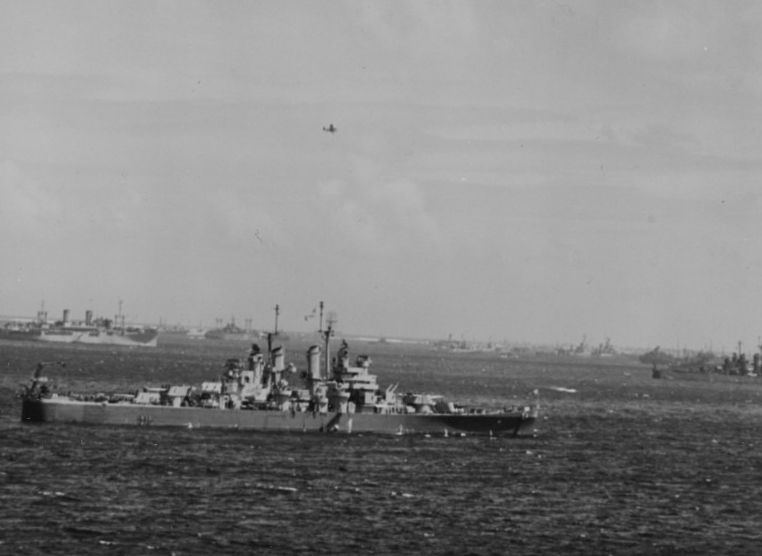
Back at sea on 14 March 1945, Miami continued her work with the carrier task force. Between the 18th and the 31st strikes were directed against southern Kyushu and Okinawa Gunto, during which time Miami faced consistent counter attacks by air. On 1 April, while steaming with TG 58.1, which included the aircraft carriers Hornet (CV-12), and Bennington (CV-20), as well as the small carrier Belleau Wood (CVL-24), she moved eastward of Okinawa where the group supported ground troops on that island through the 11th.
On 12 April 1945, Miami launched two of her Kingfishers piloted by Lt. (j.g) Henry C. Hyde and Lt. Denman W. Knight, respectively, to conduct a search for several downed aviators. At 1530 Ens. Terry Mills, a Hellcat pilot (VF-82) (BuNo 72315) from the carrier Bennington (CV-20) was pulled from the water. Two others were rescued from Amami Ōshima. Ens. John A. Halle, a Vought F4U-1D Corsair pilot of VF-10 (BuNo 82664) flying from Intrepid (CV-11), was picked up on the east side of the island. Lt. James E. Kussman, a Hellcat pilot (VF-9) (BuNo 71434) from the carrier Yorktown (CV-10), was rescued on the west side of the island. The aviators were all recovered in good health with the exception of Mills who had some “slight burns on his hands.” Lt. (j.g) Hyde and Lt. Knight were both awarded the Distinguished Flying Cross for effecting the rescue of the men in spite of their proximity to enemy forces.
At 0800 on 14 April 1945, Miami lowered her colors to half-mast in honor of the late President Franklin D. Roosevelt, who had died on 12 April. Later that same day, a large contingent of Japanese planes attacked Miami’s group, during the course of which her gunners claimed to have splashed several of the enemy planes. A similarly heavy enemy air attack occurred on the 16th but resulted in no particularly significant action with Miami.
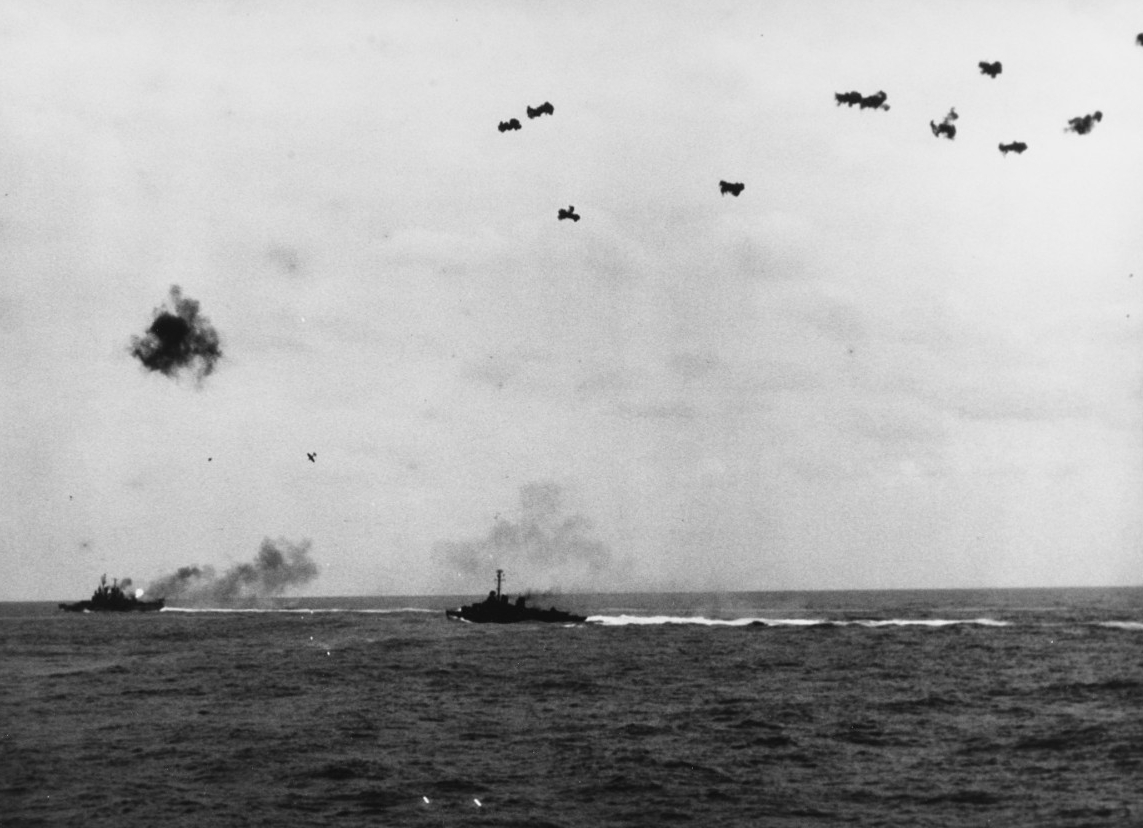
From 20 to 30 April 1945, the carrier attacks shifted over to Amami Ōshima, Tokuno Shima, and Kikai Kima. On the 30th Miami returned to Ulithi and dropped anchor, and remained there for just over a week for upkeep and re-supply. She at last got back underway on 10 May and steamed independently to Pearl, where she arrived without incident on the 17th. A number of passengers embarked on the cruiser the following day and the ship put back out to sea, shaping a course for the West Coast of the U.S. Shortly after arriving at San Pedro early on the morning of the 24th, Miami’s passengers and a number of her crew disembarked for shore leave. On the 25th she unloaded her ammunition and then went into dry dock for a scheduled overhaul.
After a month-long period of repairs and alterations Miami emerged from dry dock on 7 July 1945, and remained moored at San Pedro. The cruiser briefly got underway on the 14th to run some tests and calibrations but then returned to San Pedro the same day.
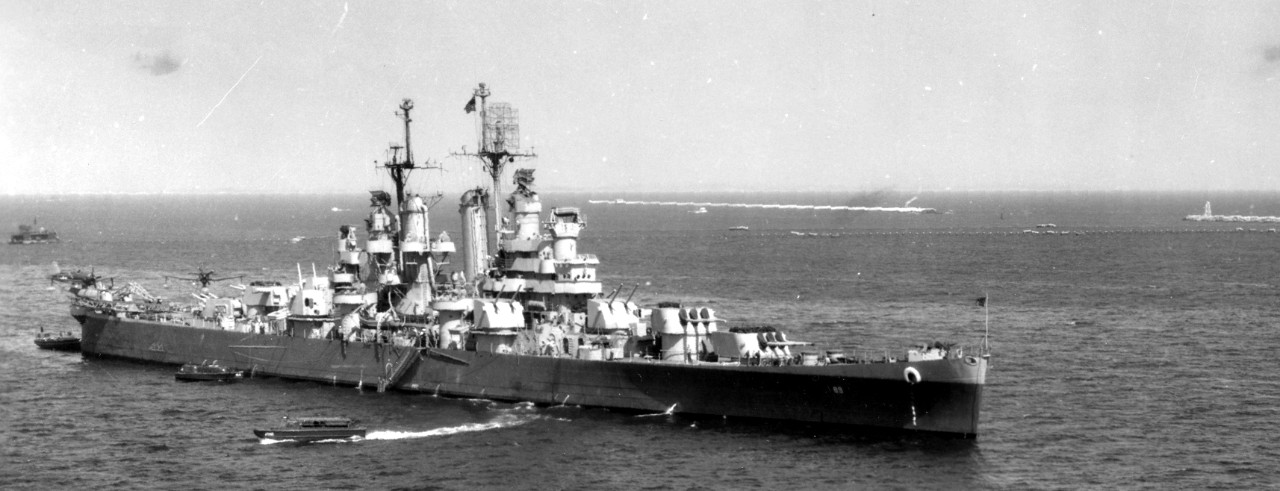
From 1 to 11 August 1945, she underwent an inspection and then on the 12th some of her Radio Countermeasures (RCM) equipment received some minor repairs. The ship at last returned to sea in earnest on 20 August, getting underway for Pearl, which she reached on the 24th. On the 30th, Miami set out for Guam and while still at sea on 2 September, at approximately 1330, her crew heard the radio broadcast telling of the surrender of Japan to the Allied powers. She arrived at Guam on 6 September and moored to a buoy in Apra Harbor.
On 9 September 1945, Miami got underway for Okinawa in company with the destroyer escort Gendreau (DE-639). Her deployment to the area was part of the buildup of U.S. naval forces in the area that were accepting the surrender of the various Japanese islands north of Okinawa. The cruiser arrived at Okinawa on 12 September and anchored in berth B-138. On the 16th she got underway with CTF 55 to avoid an impending typhoon and anchored at Buckner Bay [Nakagusuku Bay] on the 17th. Miami got underway on 22 September to support the Tenth Army as it occupied Ryūkyū-shotō. She was forced to steam south of Kikaijima on 3 October because of another typhoon and on the 7th she arrived near the port of Naze, Amami Ōshima, whence she proceeded to patrol to the northwest of that particular island. On 12 October she traversed the western entrance to the Oshima Strait and on the 15th she returned to Buckner Bay.
Miami departed Naval Base Buckner Bay for Yokosuka, Japan, on 29 October 1945, but stopped at that port only briefly before continuing on to the Caroline Islands, eventually arriving at Truk on 11 November. While at Truk she conducted a survey of the bombing damage done to the naval base there. She at last got the order to return stateside on 25 November, and following a lengthy voyage arrived at Long Beach, Calif., on 10 December.
The cruiser operated on the California coast training naval reservists until her decommissioning on 30 June 1947, whereupon she entered the Pacific Reserve Fleet. Miami's name was stricken from the Naval Vessel Register on 1 September 1961 and her hulk sold for scrapping to Nicholai Joffe Corp., Beverly Hills, Calif., on 26 July 1962.
Miami received six battle stars for her service in World War II.
| Commanding Officers | Dates of Command |
| Capt. John G. Crawford | 28 December 1943–31 January 1945 |
| Capt. Thomas H. Binford | 1 February 1945–8 December 1945 |
| Capt. Robert Bolton Jr. | 9 December 1945–14 November 1946 |
| Cmdr. William B. Braun | 15 November 1946–26 February 1947 |
| Cmdr. Algernon S. Joyner Jr. | 27 February 1947–30 June 1947 |
Jeremiah D. Foster
25 June 2019


